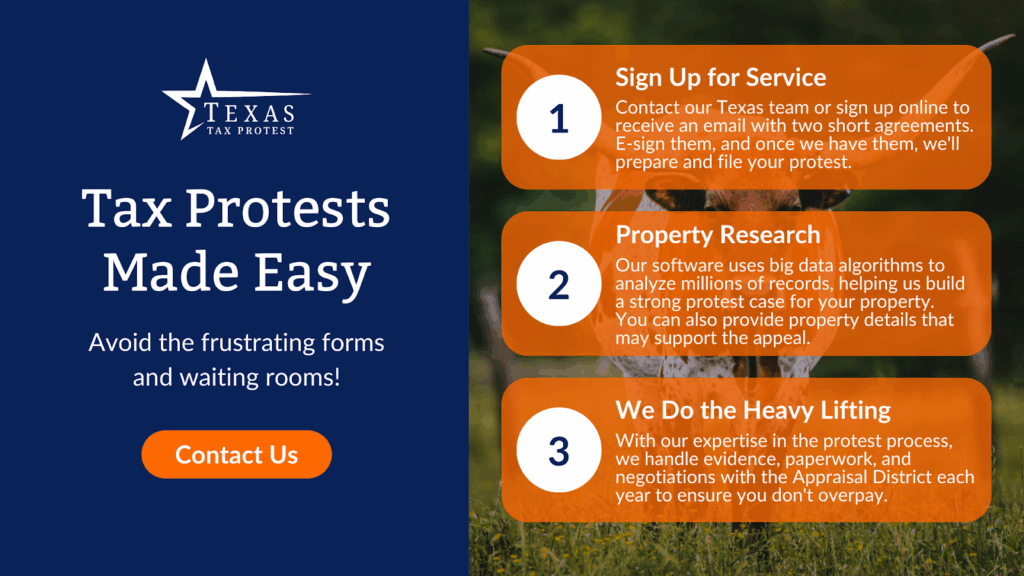
How to Estimate Your Texas Property Taxes Before They Arrive
September 2, 2025
Every spring, Texas homeowners brace themselves for that inevitable moment when the property tax appraisal notice hits the mailbox. But instead of being surprised or worse, scrambling, you can get ahead of the game. With a little strategy and the right tools, it’s completely possible to estimate your property taxes in Texas before the numbers are official.
Understanding how to calculate property taxes in Texas empowers you to budget smarter, prepare for a potential protest, and spot mistakes before they cost you.

How Property Taxes Are Calculated in Texas
At the heart of the process is a simple formula: your property’s assessed value multiplied by your local tax rate.
The assessed value is determined annually by your county’s appraisal district based on what they believe your home would sell for on the open market. The tax rate, meanwhile, is a combination of percentages set by your county, city, school district, and any special service districts in your area. Most Texas homeowners face a combined rate ranging from about 1.8% to 2.5%, depending on location.
For example, if your home’s assessed value is $350,000 and your local tax rate is 2.3%, you’re looking at an estimated property tax bill of around $8,050.
Tools and Resources for Estimating Your Taxes
Fortunately, you don’t have to do the math from scratch. Most county appraisal districts in Texas provide online portals where you can review your property’s previous assessments. Sites like the Harris County Appraisal District or Travis Central Appraisal District update values in early spring, offering a first glimpse into what’s coming.
In addition to local resources, the Texas Comptroller’s Office offers a property tax estimator tool. While it’s a statewide resource, keep in mind that actual tax rates can vary widely even within a single county, so it’s best to pull the most recent tax rate charts from your specific county’s tax assessor-collector office for greater accuracy.
Real estate platforms like Zillow and Redfin also show historical property tax data, but use them cautiously—those figures often lag behind the most current rates and exemptions.

Key Factors That Influence Your Estimate
Property values in Texas don’t move in a vacuum. Rapid appreciation in many areas, especially suburban and urban centers like Austin, Dallas, and Houston, means that even modest homes can see double-digit percentage jumps in appraised value year over year.
If your neighborhood has seen a flurry of high-priced sales or new development nearby, your assessed value may climb significantly. Conversely, if your property has unique factors (like deferred maintenance or location near a busy roadway) that could lower market value, your actual taxes might end up lower than broad market trends suggest, but only if you file a protest to correct the record.
Exemptions also play a critical role. If you qualify for a homestead exemption, senior exemption, or disabled veteran exemption, you’ll need to subtract the exempt amount from your assessed value before applying the tax rate. Many homeowners forget this step when estimating and end up predicting much higher bills than they’ll actually receive.
Why Estimating Matters: Planning Ahead for a Protest
One of the smartest reasons to estimate your Texas property taxes early is to stay ready to challenge an inaccurate appraisal. The official protest window is short, and once the deadline passes, you’re locked into that year’s tax bill.
By forecasting your property tax situation ahead of time, you’ll have an easier time gathering comps, spotting inconsistencies, and making a strong case for a lower valuation if necessary. Early preparation can mean the difference between thousands saved and thousands lost.
At Texas Tax Protest, we analyze market trends and comparable sales long before official notices drop. We know what appraisal districts look for and how to effectively counter when the numbers don’t add up.

Stay Ahead of the Curve—And Save Big
Estimating your property taxes is about taking control. Armed with the right numbers and a clear strategy, you can face tax season with confidence instead of uncertainty.
And if you discover your assessed value is out of line with reality? That’s where we come in. With over $85 million saved for Texas homeowners, and a real Texas-based support team ready to help, Texas Tax Protest makes it easy to fight back—and win. Ready to get a head start on your property taxes this year? Contact Texas Tax Protest, and let’s make sure your bill is fair and not inflated.





